
Etymological dictionary of the Altaic languages
Leiden, 2003
S. A. Starostin
Altaic problem and the origin of Japanese Language

|
Links |
|||||||||||||||||||||||||||||||||||||||||||||||||||||||||||||||||||||
| http://сувары.рф/en/node/769 | |||||||||||||||||||||||||||||||||||||||||||||||||||||||||||||||||||||
|
PDF files |
|||||||||||||||||||||||||||||||||||||||||||||||||||||||||||||||||||||
|
|||||||||||||||||||||||||||||||||||||||||||||||||||||||||||||||||||||
|
Introduction |
|||||||||||||||||||||||||||||||||||||||||||||||||||||||||||||||||||||
The mirror posting of the work by S. A. Starostin, A. V. Dybo, and O. A. Mudrak presents the invaluable collective knowledge accumulated over years of work with an objective to prove the creationist theory of genetic kinship of the Mongolian, Tungus-Manchu, Korean, and Japanese with the Türkic linguistic group. The dispute on their genetic origin is as old as the age of the linguistic studies, and the linguists' inability to sway their opponents to the opposite view amply demonstrates either the deficiency of the linguistic tools in general, or of the truncated studies when only the lexical material is studied, and the other properties of the compared languages, like the genesis of the grammatical morphemes, are wholly ignored. With such approach, no wonder that testing a leg of an elephant leads to a conclusion that an elephant is a kind of a palm tree. Fortunately, the post-publication genetic studies revealed the biological commonality of the Far-Eastern people, that is the Mongolians, Tungus-Manchus, Koreans, and Japanese, and their utter dissimilarity with the biological trunk of the Türkic peoples. That presents an insurmountable problem for the genetical unity of the Altaic languages with the Far-Eastern languages on one hand, and on the other hand an incontrovertible testimony for the demic influence. More than that, the genetic studies allowed to trace and date the distinct migratory paths of the distinct human trunks, and define the emergent locations of each trunk. The Türkic trunk appeared as a result of human migration marked by Y-DNA Haplogroup NOP which arose ~48,000 ybp, the Haplogroup P split off ~38,000 ybp presumably in South Siberia, and gave rise to haplogroups R and then R1 ~30,000 - 26,000 ybp, and Haplogroup R1b ~16,000 ybp. The daughter haplogroups R1a and R1b mark the genetic trunk of the Türkic peoples. The genetical trunk of the Far-Eastern people comes from the Haplogroup C that split ~36,000 ybp, and Haplogroup DE, which split to D and E ~42,000 ybp, these are the Mongoloid and Austronesian haplogroups of the Mongolian, Tungus-Manchu, Korean, and Japanese trunks. The last when the Far-Eastern and Türkic haplogroups were together was not 8000 ybp, but a whooping 60,000 ybp, and that is the timing when the supposed linguistic unity of the creationist theory could occur. Clearly, 60,000 ybp is linguistically to far for any sane speculations. The next time when the Türkic and the Far-Eastern paths have crossed is fairly well defined, it is the migration of the Kurgan people from the South Siberia/Middle Asia area to the Far East at around 2000-1600 BC. The migration is well-documented in archeology, legendary annals, and in languages. They are identified with Scythians and their ethnicity as Türkic. They brought along their pastoral technology, their Bronze Age technology, and their language, and it is these traces that the advocates of the creationist theory quite arbitrarily date to the 6000 BC, or 8000 ybp. Arbitrarily because the rate of change for agglutinative languages, where the root morphemes are incompatibly more conservative in comparison with the flexive languages, was arbitrarily assumed as that for the flexive languages specifically based on the IE model, without any verifiable calibration, and can't be counterchecked independently. These traces are present not only in the Tungusic languages, but also in the Sino-Tibetan Chinese language that nobody rates as an Altaic language. In China, these migrants have a name, they are the Xia and Zhou people, they are nomads and pastoralists, they invaded and symbiotised with numerous Far-Eastern people. As is typical for such cases, the facts are facts, and the interpretations are interpretations, they should not be confused. In this case, the interpretation was even drawn into the title of the book. Although the interpretative part lost its value practically immediately after its publication, the factual part will stay with us into the future, and will remain an invaluable source and a lasting memorial to its creators. |
|||||||||||||||||||||||||||||||||||||||||||||||||||||||||||||||||||||
| Table of Contents | |||||||||||||||||||||||||||||||||||||||||||||||||||||||||||||||||||||
|
|||||||||||||||||||||||||||||||||||||||||||||||||||||||||||||||||||||